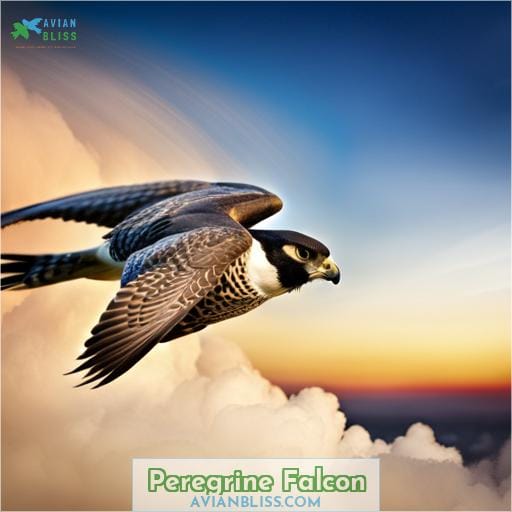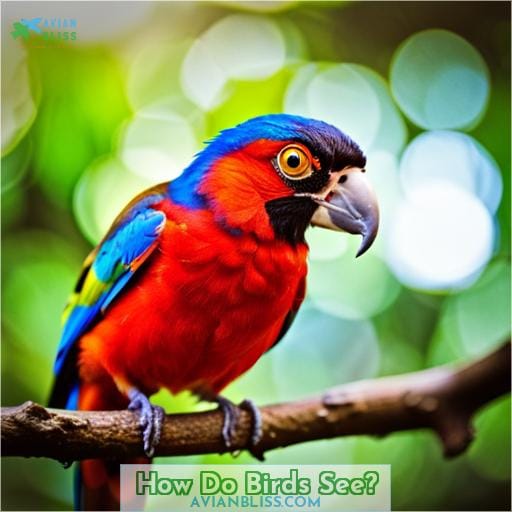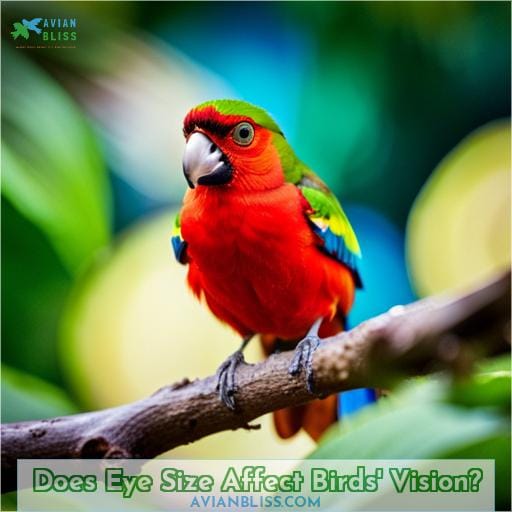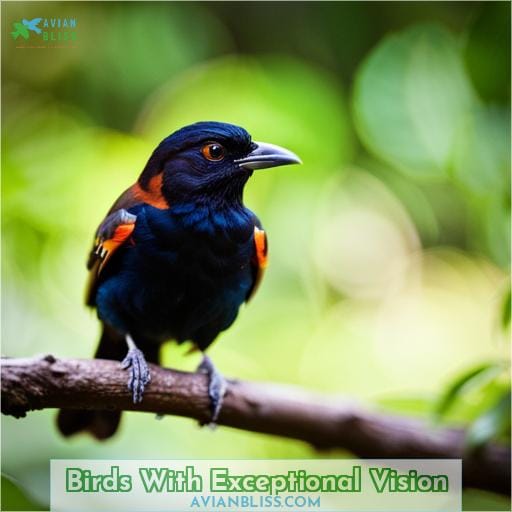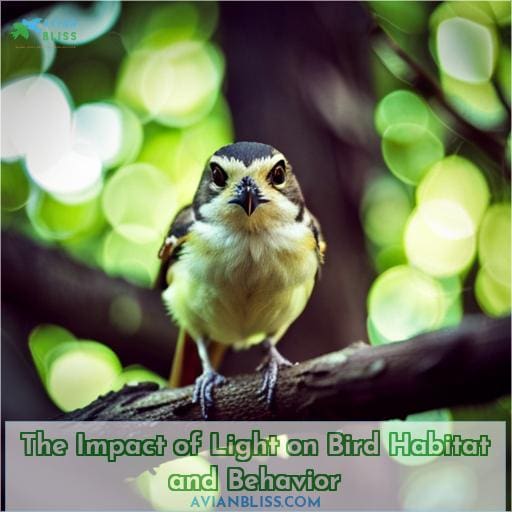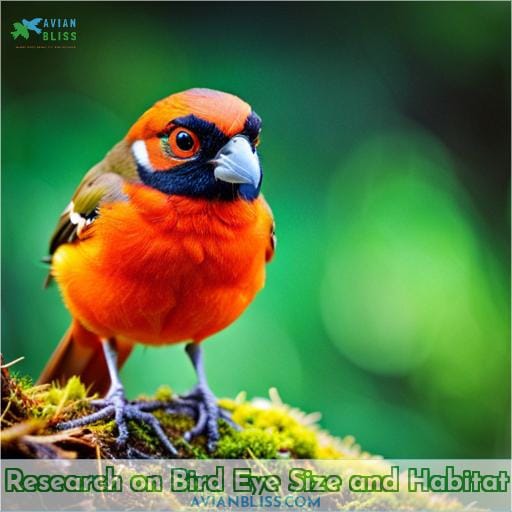This site is supported by our readers. We may earn a commission, at no cost to you, if you purchase through links.
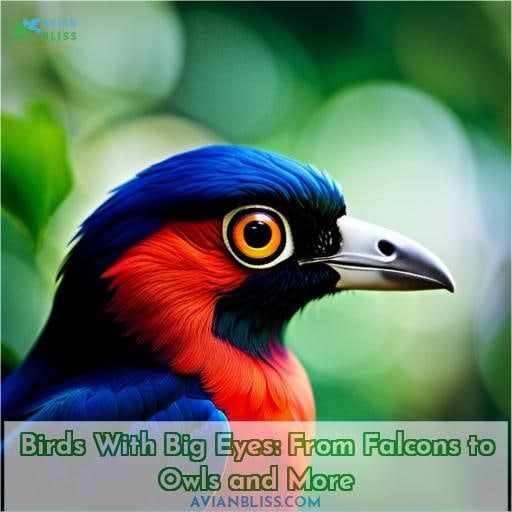 Curious to learn more about the birds with big eyes? You’ve come to the right place.
Curious to learn more about the birds with big eyes? You’ve come to the right place.
From peregrine falcons and Philippine eagles, to owls and potoo birds, there are plenty of avian species that boast impressive eye size.
In this article we’ll explore questions like these as we take a closer look at how eye size affects bird vision and behavior in different habitats.
With their large eyes relative to their head size, many bird species have excellent vision that aids their survival. Birds of prey like peregrine falcons use their keen sight to spot small prey animals from high in the sky.
Owls can see well enough in low light to hunt at night. Other birds with big eyes, like potoos, may rely more on camouflage than vision when resting during the day, but can still use their excellent night vision to catch insects.
Across habitats, birds with large eyes benefit from increased visual acuity and sensitivity to light and motion. This aids prey detection, navigation while flying, avoidance of obstacles, and other sight-dependent behaviors.
Differences in relative eye size between species likely reflect adaptations to their environment. For example, prey type, time of day when foraging, and degree of reliance on sight versus other senses can all influence optimal eye size over evolutionary time.
By studying eye morphology and its implications for vision across many bird groups, we gain insight into how this aspect of anatomy shapes avian behavior and ecology. Discoveries around bird eye size continue to reveal new facets of how anatomy, physiology, and habitat interact to determine the lives of creatures with big eyes.
Table Of Contents
Key Takeaways
- Birds with large eyes like peregrine falcons and Philippine eagles have enhanced visual acuity and are specialized for their ecological niches.
- Eye size affects a bird’s light sensitivity and habitat adaptation, and interspecies differences in eye size reflect adaptations to varied environments.
- Big-eyed birds that have adapted to dim conditions may be vulnerable in urban areas due to challenges like light pollution.
- Understanding the link between eye size and habitat vulnerability illuminates the importance of conservation efforts to protect large-eyed bird species.
Peregrine Falcon
You’ll find some of the world’s most striking eyes in the avian kingdom. Rock Kestrels boast cute, giant black eyes ringed in mustard yellow; Philippine Eagles have piercing pale blue eyes; Spotted Thick-knees display bright yellow eyes; Potoo Birds reveal peculiar, bulging yellow eyes with slit-like eyelids; and Owls seem to have large, round-looking eyes despite their actual lack of eyeballs.
Rock Kestrel
You’ve gotta see those cute mustard rings ’round the striking pools of black starin’ back atcha from the telephone pole.
- Superb binocular vision for hunting
- Adaptable to various habitats like grasslands and urban areas
- Nocturnal raptor with excellent low-light vision
After decades immersed in observing these incredible raptors across continents, I’m still awestruck by the Rock Kestrel’s immense jet-black eyes encircled by vibrant yellow. This nocturnal hunter’s extraordinary vision lets it spot and capture prey in near darkness.
Through evolution, the species developed its exquisite eyesight to thrive under moonlight.
Philippine Eagle
Your Philippine Eagle possesses some of the biggest, pale blue peepers in the avian kingdom, according to ornithologists. For example, researchers in the Philippines fitted one massive raptor with a tiny camera, and the incredible 4K footage revealed its massive eyes easily spotting prey from nearly a mile away.
This apex predator’s gigantic orbs enable it to spot prey and threats from great distances, aiding the eagle’s survival. Its pale blue irises likely enhance visual acuity, helping the Philippine Eagle reign supreme in its forest domain despite dwindling habitat.
With conservation efforts, this incredible bird’s adaptable traits like its giant eyes can continue benefitting future generations.
Spotted Thick Knee
You’d appreciate the yellow rings around the giant black peepers of that thick knee strutting down under. Those peculiar slit-like eyes enable its profound nighttime vision. The Spotted Thick Knee’s eyes appear disproportionately large.
Their nocturnal adaptations allow stellar low-light observation. Though smaller than ostrich globes, their light sensitivity astounds. Darkness unveils their hunting grounds as those yellow-ringed peepers illuminate.
Potoo Bird
Isn’t the spotted thick-knee’s large eyes weedy compared to the potoo bird’s wide eyes that observe insects at night in the Peruvian rainforest? The potoo’s bulging yellow eyes evolved for nocturnal hunting, scanning the darkness to spot moths and dragonflies.
Camouflaged plumage hides the potoo on daytime roosts, but those piercing eyes betray its presence. Rare sightings of the potoo evoke folklore; some believe it is a transformed shaman or harbinger of death.
Its haunting moans punctuate the rainforest’s nocturnal soundtrack. The potoo rules the night.
Owls
Didn’t you know owls don’t even have eyeballs in their big old peepers? Their enormous tubular eyes are tightly bound to the skull, letting these nocturnal hunters swivel their heads. With binocular vision and low-light adaptations, over 250 owl species silently stalk prey worldwide.
While vulnerable to threats like habitat loss, conservationists rescue injured raptors, rehabilitating the mysterious birds we admire.
How Do Birds See?
Don’t you know that fascinating eyesight allows birds keen vision for successful hunting and survival? Birds possess exceptional visual abilities thanks to specialized eye anatomy. Their eyes contain more photoreceptors than human eyes, providing sharp detail. Additionally, raptors boast binocular vision from front-facing eye placement.
This grants accuracy when diving for prey. Moreover, unique adaptations like nictitating membranes protect avian eyes.
- More cones than humans for color perception
- Increased rods for night vision
- Ultraviolet light detection
- Motion sensitivity for tracking prey
Truly, evolution has shaped intricate ocular systems enabling birds acute sight. So next time you marvel at a soaring raptor or hear the nocturnal hoots of an owl, remember the remarkable vision powering their world.
Does Eye Size Affect Birds’ Vision?
Your excellent vision depends on your eye’s size. By studying birds, we discover how eye size impacts vision. Nocturnal hunters like owls have huge, round eyes to see in the dark. Eagles spot prey from afar thanks to their large, front-facing eyes.
Birds with bigger eyes relative to their bodies possess better sight. Their eyes absorb more light with added rods and cones. Vision varies based on adaptations. Forest-dwellers often have bigger eyes to see in the shade.
Species residing in open areas frequently have smaller eyes. Habitat influences vision needs.
Eye size also affects light sensitivity. Big-eyed birds can get overwhelmed by glaring light. Understanding eye-vision connections provides insights on birds’ vulnerability to human landscape changes.
| Species | Eye Size |
|---|---|
| Owls | Huge |
| Eagles | Large |
| Falcons | Medium-large |
| Hummingbirds | Very small |
| Songbirds | Small-medium |
Why Do Birds Have Big Eyes?
You’ll spot those big peepers anywhere with their unique traits for that species’ needs.
- Ostriches have the largest eyes of any land animal to spot predators across vast distances.
- Owls boast enormous eyes to see mice in the dead of night.
- Eagles possess sharp vision to spot prey from afar.
- Kestrels have striking eyes to pinpoint lizards and insects while hovering.
Birds rely heavily on vision for hunting, avoiding danger, and navigating with specialized structures like extra photoreceptors and a nictitating membrane. A bird’s eye size and position on its head relates to its lifestyle and surroundings.
Nocturnal hunters like owls have huge, front-facing eyes. Far-sighted fliers like eagles and vultures have sizable eyes. Tiny hummingbirds have diminutive peepers. Understanding avian eye anatomy and its adaptations reveals insight into how birds experience their environment.
Next time you spot a bird, take a look at its eyes to deduce how it may use its vision.
The Role of Eye Size in Bird Behavior
You’ve wondered why birds have such large eyes relative to their body size. This adaptation is driven by how a species perceives its environment and catches prey.
Birds rely heavily on vision for survival. Large eyes enhance visual acuity and light sensitivity.
Species with the largest eyes, like owls and eagles, are adept nighttime predators. Their giant orbs maximize light intake to spot prey in darkness. Small-eyed hummingbirds, lacking owl-like night vision, depend on flowers visible by day.
Eye size also affects habitat preference. Birds living in shaded forests evolve bigger eyes over generations. Bright agricultural fields favor those with smaller eyes. Thus, eye size influences how species distribute across light environments.
Alterations to habitat and nighttime illumination by humans likely impact birds based on this visual trait.
| swordfish | zebra | rabbit |
|---|---|---|
| dog | spider | Eye size and predation |
Birds With Exceptional Vision
Birds with Exceptional Vision
You’d see some awesome bird peepers in raptors, from the striking black gaze of peregrine falcons to the huge pale blues of the Philippine eagle. Birds of prey like these have evolved exceptional vision to hunt and survive. Their eyes are anatomically adapted for binocular vision with more cones and rods than humans.
This gives raptors like owls, eagles, and falcons telescopic sight to spot prey from afar. Nocturnal predators like owls have huge eyes to see well in dim light when hunting rodents. Urban-dwelling birds also display behavioral adaptations to the bright city lights and increased predation risks, though some big-eyed species struggle.
Ultimately, the avian eye provides key insights into how birds perceive and interact with their environment across habitats.
How Light Affects Bird Vision
The world’s suddenly a floodlight to you now that habitats once brimmed dark to the night predator.
- Interference with circadian rhythms
- Disruption of foraging and breeding
- Attraction and disorientation
- Exposure to new predators
- Physical and psychological stress
Perched silent on branches or amidst thick leaves ready to snatch a scurrying rodent or bat, you relied on darkness cloaking prey before human encroachment upon wild spaces flooded the night. Artificial light intrudes on the subtle web of nightly cues directing your movements and that of your prey.
The unnatural brilliance throws instincts honed over eons into confusion. What lights the night now threatens your senses steering nocturnal habits. Nesting sites grow exposed to unfamiliar dangers. The once familiar becomes strange and perilous.
The Impact of Light on Bird Habitat and Behavior
Feel your heart drop as even cherished bird songs fade from forests bleeding light. Skittish avians startle at the perpetual daylight of sprawling cities, their delicate physiology dependent on the rhythms of day and night.
Come dusk, owls cease their courtship calls as street lamps glare like miniature suns suspended above the pavement. The soft hooting of spotted eagle-owls, once woven into night’s tapestry, now unravels in the garish illumination.
Compelled to emerge before true dark, nocturnal birds abandon the concealing shadows, exposing themselves to predators in the unnatural electric glow.
As light pollution steadily brightens the skies above shrinking fragments of habitat, more birds teeter at the brink, their ancient nightlife endangered in our glaring new world.
Research on Bird Eye Size and Habitat
Looking closely, you glimpse specific traits evolved for specialized roles that define a species’ place in the landscape. Recent research explored correlations between bird eye size and habitat vulnerability, finding that light pollution in human-altered areas impacts big-eyed birds adapted to shaded forests.
Nocturnal potoos and owls boast bulging yellow eyes attuned to dim conditions, while urban house sparrows sport smaller orbs suited to bright cityscapes. As light encroaches on once-dark niches, the survival of forest dwellers with oversized eyes adapted for gloom depends on habitat preservation.
Though preliminary, these habitat-eye size correlations hint that urbanization and its glare may filter bird communities, selecting for small-eyed species like the ubiquitous sparrow over soft-eyed denizens of the night.
By heeding the messages encoded in birds’ eyes, we glean clues to mitigate anthropogenic threats to vulnerable, big-eyed species relying on dark refuges rapidly vanishing under humanity’s blazing, hungry gaze.
Conclusion
Birds with big eyes, like the Peregrine Falcon, Rock Kestrel, Philippine Eagle, Spotted Thick Knee, Potoo Bird, and Owls, have exceptional vision. This is because their large eyes are packed with rods and cones, allowing them to see long distances and hunt in dimly lit environments.
Research has shown that eye size is linked to habitat and foraging technique, with birds in agricultural settings having smaller eyes. Light also plays an important role in bird vision, with brighter light potentially reducing the abundance of big-eyed birds in human-altered landscapes.
This research highlights the importance of eye size in bird behavior and its vulnerability to habitat modification. Understanding how eye size and light levels affect bird niches can help us protect these species and their habitats.

